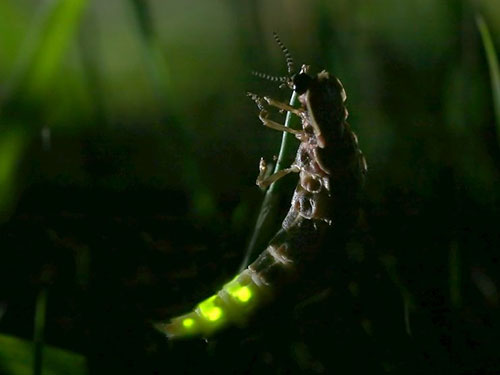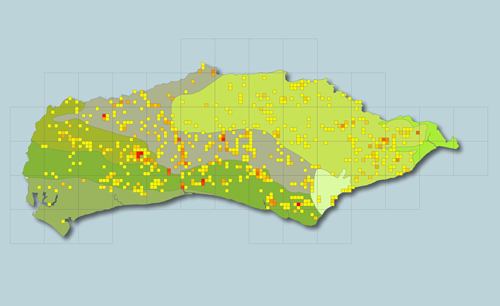


Glowing female Glow-worm
Photo: Neil Fletcher

Male Glow-worm
Photo: Derek Middleton

Glow-worm larva
Photo: Charles Roper

Heatmap of distribution of Glow-worm records in Sussex
Source: SxBRC
Glow-worms Lampyris noctiluca are sexually dimorphic beetles, with a male that resembles a traditional beetle while the females are larviforme.
You can find L. noctiluca in chalk grassland margins, edges of hedgerows and railway embankments, through June and July with lower numbers into August. The wingless females are up to 25mm long and emit a bioluminescent glow from the two bottom sections of the lower abdomen for a few hours each night in order to attract the mostly glow-less male, and can often be found sitting on a stem or leaf to show off their light. They spend the day in the understory. Adults do not feed, conserving their energy for attracting a male and mating.
Males will come to light, so if you have a moth trap or open window, keep an eye out for the mostly brown-black beetle, 15-18mm in length with brown elytra, a clear pronotum with a brown spot in the centre. Males can have a faint glow, but it is the females that will catch your eye on a summer evening.
Larvae can be seen from April to October, similar to ladybird larvae but bigger and flatter, with pale orangey spots at the edge of each segment. They can be seen on paths in daylight when looking for prey of slugs and snails, which they inject with digestive juices through a series of bites that paralyse their prey until it dissolves the soft body into a drinkable fluid.
There is a lot of science to how and why they glow which is far better explained by an expert than by me, a casual Glow-worm enthusiast, so the paragraph below is copied from the UK Glow-worm survey:
“The light from glow worms is cold, and is a form of bioluminescence. It is far more efficient than most light sources we are familiar with. It is caused when a molecule called luciferin is oxydised to produce oxyluciferin, with the enzyme luciferase acting as a catalyst in the reaction. Adult Lampyris noctiluca do not have the same control over the oxygen supply of many fireflies, which can switch their lights on and off in an instant, and take minutes to switch on or off. Larvae, however, have smaller light-emitting organs and can twinkle briefly. Male glow worms have the same ability, but it is rare to see them glow.”
The Lesser Glow-worm Phosphaenus hemipterus can be confused for the larger L. noctiluca, but both male and female of P. hemipterus are flightless, and communicate with hormones rather than light so will only illuminate when disturbed.
Glow-worm populations face a number of environmental challenges that have seen populations fall by 3.5% a year over the last 18 years. Submitting records can help give us a better picture of how populations are doing in Sussex. They are also a fantastic natural spectacle, if you have the time and enthusiasm for a late night summer walk.
More information on Glow worms can be found on the UK Glow-worm survey homepage: https://www.glowworms.org.uk/
You can submit records to iRecord using the custom form: https://irecord.org.uk/enter-glow-worm-record
Lois Mayhew
SxBRC Biodiversity Projects Officer (and resident Glow-worm fan)
Every month it is our aim to highlight a species that is “in-season” and, although not necessarily rare or difficult to identify, has been highlighted by our local recording groups as being somewhat under-recorded and for which new records would therefore be welcomed.
If you or your recording group are aware of species such as this then please contact Bob Foreman.